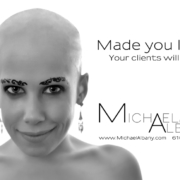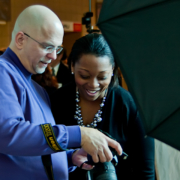My Client’s Advocate
Every once in a while things don’t go as planned. I was recently contracted for a shoot for an advertisement in a rather high end magazine. My client is the advertiser and not the magazine but the magazine is who connected me with the client. My client wasn’t sure he needed a professional photographer; he was one that thought he had a camera, and he could take the images himself and they would be ‘good enough’ for the ad. After a long consultation and some negotiation, he was willing to “give me a try.”
The shoot went well and the images were more than the client had anticipated. He was very happy with the results, in fact I would have to say that he was actually impressed with the differences between what a professional photographer could do compared to what he himself could produce. That was when he realized that ‘good enough’ probably wasn’t.
All is going well, I was paid, the images were delivered to the client and the magazine. My part was basically done; so I thought.
Now let me take a moment here to clarify; although the magazine had referred me to the client I had never done any work for the magazine before; in fact they had found me via my website and some referrals. I did not have a relationship with them prior to this project.
This past Friday evening I get a call from the client and he is furious! He is almost screaming on the phone telling me that he had received a box of copies of the magazine and his ad looked horrible! The images were all dark, lacking detail and did not represent him as he intended. He was ready to call his lawyer and have the contract voided and start a legal battle to get his money back, which I might add wasn’t a small amount.
 The client went into detail about how the images were not representing him well and in fact he felt I should be angry too as they didn’t show my talent to capture the feelings he felt the original images did. He knew that I did not have a relationship with this publication prior to this project and felt that I should be as angry as he was because how was I going to get more work from this magazine if my images “looked like crap.” He was right too; if my work is the ugliest in the magazine it is highly unlikely that I would get any further referrals from the magazine.
The client went into detail about how the images were not representing him well and in fact he felt I should be angry too as they didn’t show my talent to capture the feelings he felt the original images did. He knew that I did not have a relationship with this publication prior to this project and felt that I should be as angry as he was because how was I going to get more work from this magazine if my images “looked like crap.” He was right too; if my work is the ugliest in the magazine it is highly unlikely that I would get any further referrals from the magazine.
The fact that my client was not happy is more of an issue for me than anything else. A positive review from him is likely to do more for me than how the magazine feels. More importantly, my client is pissed and that is just not acceptable to me, period.
But I am just the photographer, what can I do? This is an issue between the client and the magazine. In fact I could do something.
I had the client overnight a copy of the publication and I took a critical look at the ad and yes, the representation sucked. The images were dark, fuzzy at times and just generally looked horrible. So I did what I thought would be the next right thing, I called my contact at the magazine and I asked them what happened.
My contact had not yet seen the printed version and referred to the soft proof that she could see on her computer. She forwarded me a copy of the proof while we were on the phone and I let her know that the files she sent me in fact did not in any way represent what I was seeing in print. She then in turn referred me to the manager of their production department and my questioning began all over again.
To make a long story short, or at least not so long, After comparing files, computer profiles, processes and anything else we could think of it was finally agreed that the print version didn’t match the electronic version and that something needed to be done to make it right.
I offered the magazine an additional 30 images to choose from and my time and knowledge to work with them to create a new advertisement for my client. I would be the advocate for my client and I would use my print experience to help create a new ad. They in turn offered to run an editorial about my client’s product next to a full page ad that we would compose together. This would give my client greater exposure than originally planned, gave him a discount of more than 60% on his previous contract, and should override any negative exposure that may occur from the copies that were already on the street.
My client wasn’t sure how to negotiate with the publication when the project was less than expected and was put in a place where he was not sure how to proceed. He was about to do what he thought was right and bring in legal counsel. Instead he reached out to the person he thought might have an idea on how to handle the situation, even if it was more to assure him that the ad looked bad. In doing so, he brought in an advocate for himself and his business.
I didn’t charge the magazine or my client for any of this. I wanted to do what was right for my client and for everyone involved. In doing so I was able to help my client; I took a bad situation and made it a Win/Win/Win. The client gets a second ad with a two page spread for the cost of a half page ad, the publication gets a happy client and a minimal financial compromise, and I have two happy clients.
Being my client’s advocate is for me, just smart business.












Michael-
a great solution to a difficult problem. As a editorial art director, I realize that some things are not in our hands. Your willingness to go the extra mile for your clients, and the magazine’s willingness to work with this advertiser to resolve his concerns in a satisfactory matter turned the whole ship around. Bravo!
Congratulations Michael!
… and thank you for sharing this difficult experience. You handled it with integrity and dedication and, it would be interesting, to read in the future an example of the “win/win/win” from this.
The way business should be done….
It seems so few people these days have strong business ethics, it was refreshing to read your article and while you may have lost out on some short term income your integrity with the clients and your reputation will pay off in the long run. Kudos to you Michael. Thanks for sharing.
That is always the way to go. Especially since this represents your work as well. If you client thought their product looked bad…well then yours looks just as bad if the printers messed up! I always tell my clients when there is a third party involved that I am willing to be a “technical go-to” person if they need help. Often they don’t understand the print world, or how and what to ask for to ensure the work gets translated correctly to the next medium.
I generally don’t charge for this either as my own reputation and work is on the line and I want it to look stunning, anywhere it is shown.
Good job on this one! I recommend others do the same!
Well done Michael, and also well shared! This is a great example of how to potentially turn an angry customer into your businesses best friend and advocate. The question that still remains, for me, is what happened to make the original ad look bad? Was it something the printers did?
Michael,
I agree that you handled this in outstanding fashion. I’m just curious about one thing: did the entire publication “look like crap”, or was it just your ad? If it was only your page(s), were you able to identify a specific cause of the problem?
I’ve never experienced anything of this nature at quite this level. By that I mean I’ve occasionally seen my work reproduced in print in ways that left something to be desired, but nothing that would infuriate a client or justify the time and effort you expended to resolve this in an amicable way. If you delivered image files produced on properly calibrated and profiled equipment (as I’m sure you did) how could this happen? The answer might be instructive for all of us.
Alan
Just to update everyone – it is still an undetermined if it was the printer or the production department. I am willing to guess that it was some combination of the two. I really don’t think anyone ever looked at the proofs and just went to print “as is” (we were close to the deadline) and that is never a good strategy.
What a fantastic story, and a wonderful way to keep everyone in a winning situation when the opposite could easily have been the result.
You did a marvelous, intelligent, job of keeping your head, thinking the problem through, and implementing a solution where not only everyone wins, but you have certainly won two new clients!
Congratulations Michael!
Alan – the takeaway should be that never let your work be printed without a hard copy proof provided that is using the exact setup that the printer will use on the same machine they will be printing on. Other than that bit of wisdom it is a mystery as to what really happened.
This is what we, as professionals, do. Good work.
I’ve worked in retail (art and custom framing) for over 20 years, and I’m convinced that how you handle problems and mistakes will create loyal customers or loose them. The inevitable problems /mistakes are an opportunity to show how good you can be. Thank you for sharing your experience!
Fabulous article Michael, something that all clients and potential clients should see when they hire the “right person”.